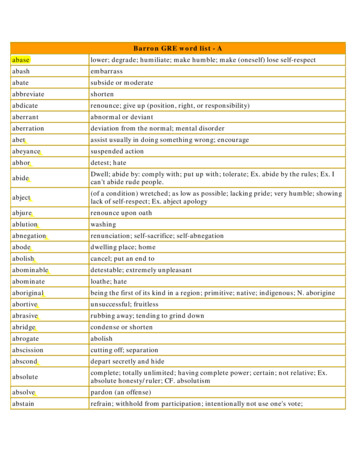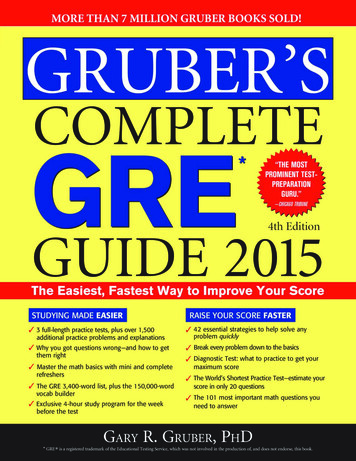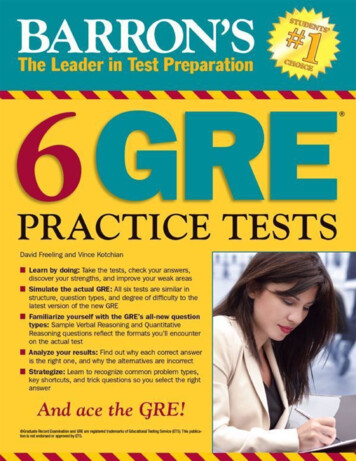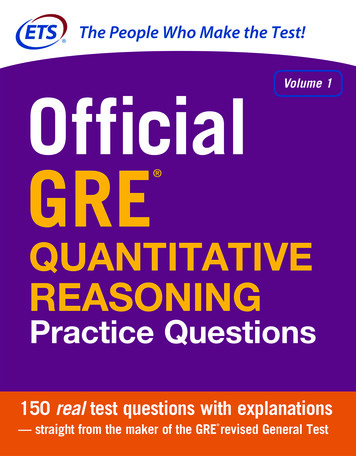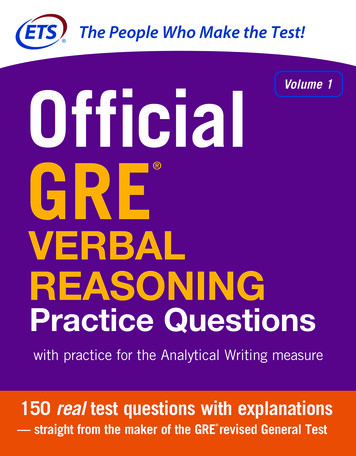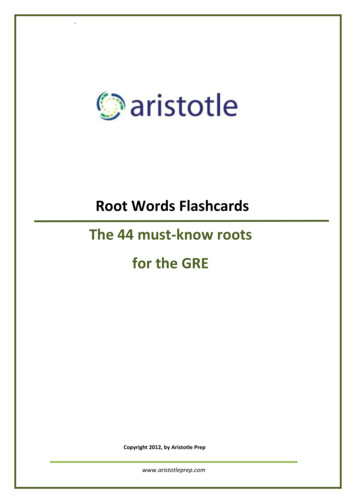
Transcription
PRACTICE MATH SUBJECT GRE PROBLEMS.All logarithms with unspecified base are natural logarithms with base e.sin(x3 ) x 0 x (cos (2x) 1)11(B) 2(C)(D) 22Problem 1. lim(A) 2Problem 2. lim(A) 0x (B) 1log(x) x1/41(C)4(D) 4(E) 1(E) Does not existpx2 x x x 11(B) 2(C)(D) 22(A) 2Problem 4. lim (A) 0x (B) 1 Problem 5. limx (A) 1(B) 1/eˆx x2 11(C)2231 2x x(C) eLin on:Problem 3. lim(E) 1(E) (D) 2 x (D) 1/e2ˆ(C) 2 25 5 153e1/xdx x21 (C) e 3 e(B) e eProblem 8.(A) eˆ(D)1e3(E)11 e e31ex 1dx x0 e x(B) e(C) 1 eProblem 9.(A) 1ˆ(D) log(1 e)(E) log(e ee )π/2cos2 x dx Problem 10.0(A) π/3(B) π/4(C) π/8(D) 1/2(E) 1/4Problem 11. Which of the following shows the numbers 2730 , 540 , 460 in increasing order?(A) 2730 540 460(B) 2730 460 540603040(C) 4 27 5(D) 460 540 2730406030(E) 5 4 27Problem 12. Which of the following shows the numbers 101/9 , 91/10 , 81/11 inincreasing order?(A) 101/9 91/10 81/11(B) 101/9 81/11 91/101/111/91/10(C) 8 10 9(D) 81/11 91/10 101/91/101/111/9(E) 9 8 10(E) e2Problem 13. Which of the following shows the numbers eπ , ee , π e in increasingorder?(A) eπ ee π e(B) ee eπ π eeeπ(C) e π e(D) π e ee eπeπe(E) π e e4log x dx x1(A) log(64) 1(B) log(64) 4(D) log(128) 4(E) log(256) 4px2 1dx 2 (B)25 5 215 1 (E)5 21520201. Calculus.2Problem 7.x31 2 (A)5 215 2 (D)5 25Thursday 13th August,Prepared by Bon-SoonBon-Soon Lin (Updated Thursday 13th August, 2020 at 2:09pm)ˆProblem 6.(C) log(128) 11
PRACTICE MATH SUBJECT GRE PROBLEMS.Bon-Soon LinProblem 18. The following is the graph of the derivative f 0 of a function f :nXk4 n n5k 111(C)(B)23Problem 15. lim(A) 1(D)14(E)151Thursday 13th August,Prepared by Bon-SoonProblem 14. Which of the following shows the numbers 200!, 100200 , 200100 inincreasing order?(A) 200! 100200 200100(B) 200! 200100 100200100200(C) 200 200! 100(D) 200100 100200 200!200100(E) 100 200 200! 1012 1Which of the following must be true?I. f (0) f (1)II. f has a maximum between the interval (0, 2)III. f has a maximum between the interval ( 1, 1)(A) I only(B) II only(C) III only(D) I and II only(E) I and III onlyLin on:Problem 16. Let p(x) be a polynomial such that p(3) p0 (3) 0. What mustbe true about p?I. The degree of p must be at least 2.II. There is a local maximum at x 3.III. There is a local minimum at x 3.(A) I only(B) II only(C) III only(D) I, II, and III(E) None of I, II, III0ˆProblem 19. The following is the graph of F (x) Problem 17. The following is the graph of the derivative f of a function f : 1012202011 1 101 1Which of the following must be true?I. f is decreasing on the interval (0, 1)II. f ( 1) f (0)III. f ( 1) f (1)(A) I only(B) II only(C) III only(D) I and II only(E) I and III onlyWhich of the following must be true?I. f (x) 0 for all x ( 1, 0)II. f has exactly one root in the interval (0, 2)III. f (0) 0(A) I only(B) II only(C) III only(D) I and II only(E) I and III only2f (t)dt, where f is some0continuous function:2x
PRACTICE MATH SUBJECT GRE PROBLEMS.Bon-Soon LinProblem 20. The following is the graph of f , some twice differentiable function:Problem 23. Suppose h is a continuous real-valued function such thath0 (x) 0 on (0, 1), and h(1) h00 (2) 0.012 10Which of the following CANNOT be true?I. There exists at least two points p, q in ( 1, 2) such that f 00 (p) f 00 (q).II. There exists a point r ( 1, 0) such that f 0 (r) 1.III. There exists a point s (0, 1) such that f 00 (s) 0.(A) I only(B) II only(C) III only(D) I and II only(E) I and III onlyx x Lin on:00y (1) 0, y (1) 0, and y (2) 0.Which of the following could be part of the graph of y?(A) 1(B) 1(C)0102 1102 1(D)0 112102(E)1112 110102 112 1Problem 24. Suppose g is a differentiable function such that g 0 (x) g(x) 0for all x R. Which of the following could be part of the graph of g?(A) 1(B) 1(C) 10102 1102102 1(D) 1(E)111 1(D)Problem 22. Suppose y is a continuous real-valued function such that0002 1Problem 21. Let g be a twice differentiable function. Suppose g 0 (x) 0 andg 00 (x) 0 for all x R. Which of the following must be true?I. lim g(x) II. lim g(x) III. g is injective(A) I only(B) II only(C) III only(D) I and III only(E) II and III only1 12020 1Which of the following could be part of the graph of h?(A) 1(B) 1(C)Thursday 13th August,Prepared by Bon-Soon11212 1(E)1012 1101Problem 25. The region bounded by the curves y 1/x, x 1, x 2, y 0is rotated about the x-axis. The volume of the resulting solid of revolution is(A) π(B) π/2(C) π/3(D) π ln 2(E) π ln 32 13
PRACTICE MATH SUBJECT GRE PROBLEMS.Bon-Soon LinProblem 32. If g is differentiable on the interval ( 3, 3) and that g 0 (x) 6 2 forall x. If g( 1) 1, what is the largest possible value of g(2)?(A) 5(B) 6(C) 7(D) 8(E) 9Problem 33. If g is differentiable on the interval (0, 5) and that g 0 (x) 2 forall x. If g(1) 5, what is the smallest possible value of g(4)?(A) 5(B) 7(C) 9(D) 11(E) 13Thursday 13th August,Prepared by Bon-SoonProblem 26. Let p be a nonconstant polynomial of degree 5. Which of thefollowing must be true?I. The graph of p has three inflection points, points where the second derivativechanges signs.II. Between any two distinct roots of p, there exists a local maximum or minimumof p.III. The graph of p crosses the x-axis at least twice.(A) I only(B) II only(C) III only(D) I, II, and III(E) None of I, II, IIIProblem 27. The region bounded by curves y x and y xn for some integern 2 in the first quadrant of the xy-plane is rotated about the x-axis. If the4πvolume of the resulting solid is, what is n?15(A) 3(B) 4(C) 5(D) 6(E) 7Problem 34. Consider the function f (x) x x3 2x . Which of the followingstatements must be true?I. f has at least one root on the interval ( 3, 0)II. f has at least one root on the interval (1, 2)III. f has at least two roots on R(A) I only(B) II only(C) III only(D) I and II only(E) II and III onlyProblem 28. The region bounded by curves y x and y xn for some integern 2 in the first quadrant of the xy-plane is rotated about the y-axis. If the4π, what is n?volume of the resulting solid is15(A) 3(B) 4(C) 5(D) 6(E) 7Problem 35. Consider the function f (x) 1 2x x3 4x5 . How many realroots does f have?(A) 0(B) 1(C) 2(D) 3(E) 5Problem 36. Let g be a continuous real-valued function such that g(x) ˆ sin(x)cos(x)dx. What is g 0 (0)?0(A) 0(B) 1(C) cos(1)(D) cos(sin(1))(E) sin(sin(1))2020Lin on:Problem 29. The region bounded by curves y x2 and x y 2 is rotatedabout the line x 1. The volume of the resulting solid of revolution is13142916(A) π(B)π(C)π(D)π(E)π310153045Problem 37. Let g be a continuous real-valued function such that g(x) ˆ x2et dt. What is g 0 (4)? Problem 30. The region bounded by curves y 1 sec x and y 3 is rotatedabout the line y 1. The volume of the resulting solid of revolutionis ! 4423(A) ππ 3(B) 2ππ 3(C) ππ 3333 ! 232(D) 2ππ π 3(E) 2π333x(A) e8 e(B) e16 e21(D) 2e16 e22(C) 2e16 e21(E) 8e16 e24Problem 38. Let g be a continuous real-valued function such that 12e2x 1 ˆcg(t)dt. What is the value of c?Problem 31. If g is differentiable on the interval ( 2, 4) and that g 0 (x) 3for all x. If g(3) 9, what is the largest possible value for g( 1)?(A) 1(B) 2(C) 3(D) 4(E) 5x(A) 14(B) 1(C) log 12(D)1log 1221(E) log 122
PRACTICE MATH SUBJECT GRE PROBLEMS.Bon-Soon LinProblem 39. Let g be a continuousreal-valued function such that for all posiˆ xg(t)dt, for some real number c. How many possibletive x we have x3 x Problem 47. Let f be the function defined by f (x) (B) t2 1257 (C) 2 17(D) 1 x x logProblem 42. Let f (x) sin(x) and g(x) ln x both defined on R\{0}. Forhow many x R\{0} do we have f (x) g(x)?(A) 0(B) 1(C) 2(D) 3(E) 4f 0 (π) (A) 111 x(E) 1 x x log(C) x x log11 x(B) 0(C) 1(D) 2x 0. Then f 0 (x) 11(A)(B) 2xx nX(sin x). Thenn!n 0 X(x 1)n on 2 n 0(C)11 x(D)1(1 x)2(E)x1 xg(x) g(x2 )(E) The limit does not exist.Problem 51. Let g be a function that g(x) log(x 1). Then lim(A) 0x 1Problem 45. How many real solutions does the equation 2 x2 have?x 1(A) 0(B) 1(C) 2(D) 3(E) 4(B) 1(C) log 2x 0(D) log 4g(x2 ) x 0 g(x)2(E) The limit does not exist.Problem 52. Let g be a function that g(x) log(x 1). Then lim(A) 0 X1xn on 1 n 1n 0(B) 1(C) log 2(D) log 4x4 x 0 g(g(x))Problem 53. Let g be a function that g(x) arctan(x2 ) . Then lim(C) 4(D) log 211 x(E) 3Problem 50. Let f be the function defined by f (x) Problem 44. Which of the following equations has the greatest number of realsolutions?(A) x5 2x 3 0(B) x2 x 1 0(C) x4 x2 1 ex(D) sin x x2(E) e x x2Lin on:(B) x (1 x) log(1 x)Problem 49. Let f be the function defined by f (x) Problem 43. Let f (x) sin(2x) and g(x) ln x both defined on R\{0}. Forhow many x R\{0} do we have f (x) g(x)?(A) 0(B) 1(C) 2(D) 3(E) 41x 1. Then f ( ) 2(A) 1(B) 2(E) 60(A) (1 x) log(1 x)Problem 41. How many real solutions does the equation x2 2x 0 have?(A) 0(B) 1(C) 2(D) 3(E) 4Problem 46. Let f be the function defined by f (x) (D) 5 XxnProblem 48. Let f be the function defined by f (x) on 1 x 1.nn 1ˆ xThenf (t)dt 1 u4du, then F 00 (2) u1 17(D) 17(E)4f (t)dt, where f (t) (C) 42020 (A) 2 257ˆxProblem 40. If F (x) (E) 5Thursday 13th August,Prepared by Bon-Soonˆ(D) 4n2 xn on 1 x 1.n 01Then f ( ) 2(A) 2(B) 3cvalues of c are there?(A) 1(B) 2(C) 3 X(E) log 4(A) 15(B) 2(C) 3(D) 4(E) 5
PRACTICE MATH SUBJECT GRE PROBLEMS. Problem 54. limx 0(A) 1(B)1211 22sin x x1(C)3Bon-Soon Lin Problem 61. The following depicts the graph of f 00 for some real-valued function f . How many inflection points of f are there in the interval ( 1, 2)? (D)14(E) The limit does not exist.Problem 55. lim(A) cos ex 0 sin xx 1/x2 (B) e 1/6(C) e1/3ˆ(D) 03Problem 56. What is the value of(A) 9 3(B) 6(C) 2e9 sin(3)ˆ2Problem 57. What is the value of(B)1 1/4e log 34(C) log 3ˆ(B) e2(C) e 21e4(C)11 x2(E) 1/551 2 e4 2xe x x dx?0(D)ˆ51 4 e4(E)(B) 2(C) 32 1(A) 1(B) 2(C) 3(D) 4(E) 5Problem 62. The following depicts the graph of f 0 for some real-valued functionf . How many inflection points of f are there in the interval ( 1, 2)?1dx?0 112 1(A) 1(B) 2(C) 3(D) 4(E) 5Problem 63. The following depicts the graph of f for some real-valued functionf . How many inflection points of f are there in the interval ( 1, 2)? 151 2 2e41012 1(A) 12(B) 2(C) 3(D) 4(E) 5Problem 64. Consider the polynomial p(x) (x 1)(x 2)2 (x 3)4 (x 4)3 .How many inflection points does p have?(A) 0(B) 2(C) 4(D) 6(E) 81dx1 ex 2(D) 4(E) 0Problem 60. What is the value of(A) 11 ex e xdx?x x 1 e e1e 1/e(E)(D)e 1/ee 1/eˆ(B)(D) 1/3(E) 01Problem 59. What is the value of(A) 0 2sin3 (1 x)e1 2x x 0Problem 58. What is the value of(A) 0 2xex cos(x) x dx? 2 9(D)e sin(3)2Lin on:(A) 0 (E) 10 12020 Thursday 13th August,Prepared by Bon-Soon16
PRACTICE MATH SUBJECT GRE PROBLEMS.Bon-Soon LinProblem 72. Let c be some positive number such that the graph of cex intersects the unit circle x2 y 2 1 at exactly one point. What is the x-coordinateof this point of intersection? 2 51 51 52 5(C)(D)(E)(A) 0(B)2222Problem 65. How many inflection points are there for the function f (x) 2 cos(2x) on the interval (0, 10)?(A) 0(B) 2(C) 4(D) 6(E) 8Thursday 13th August,Problem 73. For what positive value of c does the graph of y the unit circle x2 y 2 1 at exactly two points?1111(A) 1(B)(C)(D)(E)2335Problem 67. Let f be a differentiable function defined on R that is tangent to2the curve g(x) ex at x 1. What is (g f )0 (1)?222(A) 4ee 2(B) 4ee(C) 4e2(D) 4ee 2(E) 4e2 2Problem 68. Suppose f : R R is differentiable and bijective with f (0) π,and for each x R,2f 0 (x) 3 e x cos(f (x)). 0Find f 1 (π).1ππ1(C)(D)(E)(A) 1(B)2323Problem 75. For which value(s) of c does the equation c(x 2) 1 x2 haveexactly one solution? (A) 2 3 and 2 3 only (B) 4 2 3 and 4 2 3 only(C) 2 3 only(D) 2 3 only(E) 4 2 3 onlyProblem 69. Suppose f : R R is differentiable and the line y 3x 2 is0tangent to the graph of f at x 5. What is (log(f (x))) (5)?33333(A)(B)(C)(D)(E)513151719Lin on:cintersectsxProblem 74. The graph of y cx2 1 intersects the unit circle x2 y 2 1at (0, 1). What is the minimum value of c such that (0, 1) is the only suchintersection point?11(C) 0(D) (E) 1(A) 1(B)22ˆ9x2 1 4x2 13(9x2 1) 2(4x2 1) 2(B) 29x 1 4x 19x2 14x2 13(x2 1) 2(x2 1)4(3x)24(2x)2(D) (E) 2222x 1x 1(9x2 1)(4x2 1)(A)Problem 70. Suppose f (x) is a differentiable real-valued function and is definedimplicitly byf (x) ex log (f (x)) 1. 0What is f 1 (e)?1 11(B) 2(C) 2(D) e2 1(E) e2 e(A) 2e 1e ee eˆ 1 2xdProblem 77.t sin t dt dx 1 2x(A) 2(1 2x) sin(1 2x) 2(1 2x) sin(1 2x)(B) 2(1 2x) sin(1 2x) 2(1 2x) sin(1 2x)(C) 2(1 2x) cos(1 2x) 2(1 2x) cos(1 2x)(D) 2(1 2x) cos(1 2x) 2(1 2x) cos(1 2x)(E) None of the above Problem 71. For what value of c does the equation ex c x have exactly onereal solution for x? (A) 2(B) e(C) 2e(D) 2 e(E) e 273x 2t 1dt?22x t 1x2 1 x2 1(C) 2 x 1 x2 1Problem 76. What is the derivative of the function f (x) 2020Prepared by Bon-SoonProblem 66. Let f be a differentiable function defined on R whose derivativeis strictly positive. Suppose the line y 2x 5 is tangent to the graph of f atx 3. Which of the following is NOT true? 01(A) f (3) 11(B) f 0 (3) 2(C) f 1 (11) 2(D) f must be injective(E) f must be surjective
PRACTICE MATH SUBJECT GRE PROBLEMS.Bon-Soon Linˆ1x(B) ( , 0)ˆProblem 80. If f (x) g 00 (π/3)? 7(A) 42(C) ( 1, 1)sin(x)(D) ( , 1)ˆp21 t dt and g(x) 1 7(B)4Problem 85. Which of the following series converges? n2 XnI.n 1n 1 X1II.1 1/nnn 1 nX n2 1III.(1 t2 )et dt. Which of the following intervals isProblem 79. Let f (x) f increasing?(A) (0, )Problem 84. Let f (x) (x2 x 1)ex . What is the 19-th derivative of fevaluated at x 0? Namely, what is f (19) (0)?(A) 342(B) 352(C) 362(D) 372(E) 382Thursday 13th August,Prepared by Bon-Soonˆ x2darctan t dt Problem 78.dx x11(A) 4 x 1 x 112x (B) 4x 1 2 x (x 1)(C) arctan x2 arctan x 1(D) 2x arctan x2 arctan x2 x 12(E) 2x arctan x arctan x2 x(E) (1, )1Problem 86. How many positive numbers x satisfy the equation sin(50x) x?(A) 10(B) 15(C) 20(D) 25(E) 30f (t)dt, then what isx 1 3(C) 2n 1(A) I only(B) II only(C) III only(D) I and III only(E) I, II, and III all converges 1 3(D)2r(E)1 32Problem 87. How many real numbers x satisfy the equation x18 e x ?(A) 1(B) 2(C) 3(D) 4(E) 5Problem 82. What is the 10-th derivative ofx?e2x(A) 1024(x 5)e 2x(B) ( 1024x 10)e 2x 2x(D) 1024xe(E) (1024x 10)e 2xProblem 88. Which of the following has the greatest number of real solutions?(A) x3 x 0(B) x9 x 0(C) x12 x 0(D) x15 x 0(E) x21 x 02020Lin on:Problem 81. Let f (x) (x 1) sin x. What is the 10-th derivative of fevaluated at x 0? Namely, what is f (10) (0)?11(A) 10(B)(C)(D) 9(E) 9!99!(C) 1024xe 2xProblem 89. How many real numbers x satisfy the equation sinh(x) cosh(x)?(A) 0(B) 1(C) 2(D) 4(E) Infinitely manyProblem 83. What is the 20-th derivative of (x2 x) cos(x)?(A) (2x 1) cos(x) (x2 x) sin(x)(B) (2x 1) cos(x) (x2 x) sin(x)(C) (x2 x) cos(x) (2x 1) sin(x)(D) (x2 x 380) cos(x) (40x 20) sin(x)(E) (x2 x 380) cos(x) (40x 20) sin(x)Problem 90. How many real numbers x satisfy the equation esin(x) 1 x2(A) 0(B) 1(C) 2(D) 4(E) Infinitely many8
PRACTICE MATH SUBJECT GRE PROBLEMS.Bon-Soon LinProblem 92. A runner sprints around a circular track of radius 100 m at aconstant speed of 7 m/s. The runner’s friend is standing at a distance 200m from the center of the track. How fast is the distance between the friendschanging when the distance between them is 200 m?7 7 7 (A)15 m/s(B)15 m/s(C)5 m/s422 77(D)5 m/s(E)25 m/s44Problem 97. lim (n 4)2/3 n2/3 n 2(A) 0(B) 1(C) 4(D)3Thursday 13th August,Problem 96. Let g(x) x x defined on the real line. Which of the followingis true?I. The graph of g has an inflection pointII. g 0 (0) existsIII. g 00 (0) exists(A) I only(B) II only(C) III only(D) I and II only(E) None of themPrepared by Bon-SoonProblem 91. The altitude of a triangle is increasing at a rate of 1 cm/minwhile the area of the triangle is increasing at a rate of 2 cm2 /min. At what rateis the base of the triangle changing when the altitude is 10 cm and the area is100 cm2 ?(A) 0 cm/min(B) 1.4 cm/min(C) 1.4 cm/min(D) 1.6 cm/min(E) 1.6 cm/minProblem 98. Let f be a real-valued continuously differentiable functions on R,defineˆ xLin on:f (t)(t x)dt.g(x) 0Then g 0 (x) Problem 93. The top of a ladder slides down a vertical wall at a rate of0.15 m/s. At the moment when the bottom of the ladder is 3 m from the wall,it slides away from the wall at a rate of 0.2 m/s. How long is the ladder?(A) 2 m(B) 3 m(C) 4 m(D) 5 m(E) 6 m(A) 0(B) f (x)ˆ(C) xf (x)ˆxf (t)dt(D)(E) 0xf (t)dt0Problem 99. For any two real-valued infinitely differentiable functions f andg on R, defineˆ x(f g)(x) f (t)g(x t)dt.Problem 94. The volume of a cube is increasing at a rate of 10 cm3 /min. Howfast is the surface area increasing when the length of an edge is 30 cm?21(B) cm2 /min(C) 1 cm2 /min(A) cm2 /min3345(D) cm2 /min(E) cm2 /min33Problem 95. If a snowball melts so that its surface area decreases at a rate of1 cm2 /min, find the rate at which the diameter decreases when the diameter is10 cm/min(E)cm/min3π4π(E) 02020Then (f g)00 (x) (A) (f g 00 )(x)(B) (f g 00 )(x) f 0 (x)g(0)(C) (f g 00 )(x) f 0 (x)g(0)00000(D) (f g )(x) f (x)g (0)(E) (f g )(x) f (x)g 0 (0) f 0 (x)g(0)Problem 100. Let f be a real-valued continuously differentiable function onR, defineˆ xg(x) f (x t)(x t)dt.0Then g 0 (x) (A) 0ˆ(D)90(B) f (x)ˆ(C)xf 0 (t)(x t)dtˆ x(E)[f 0 (x t)(x t) f (x t)]dt0xf 0 (x t)(x t)dt0
PRACTICE MATH SUBJECT GRE PROBLEMS.π/20(A) 0(B) 11 dx 1 tan xππ(C)(D)24Problem 108. What is the volume of the solid in xyz-space bounded by thesurfaces z 1 x2 , z x2 1 and the planes x y z 2, x 2y 2z 10 0.56565656(B)(C)(D)(E) 1(A)35925(E) Prepared by Bon-Soonˆ(B) 2n 1(A) n 1ˆ0(C) n!(D) (n 1)!271 dx 3x x8 rr 33(A) 1(B) 6 log(C) 6 log 10 2 12 322 3 13 1(D) 6 log (E) 3 10 2 12 3 6 log 2 12 1Problem 103.ˆProblem 104.π(A)40π2(B)4π xn e x dx Problem 102. For each non-negative integer n, we havex sin(x)dx 1 cos2 xππ2(C)(D)22(E) 1(E) nThursday 13th August,ˆProblem 101.Bon-Soon LinProblem 109. What is the volume of solid in xyz-space under the surfacez xy and above the triangle with vertices (1, 1), (4, 1), and (1, 2)?163145(A) 1(B)(C)(D)(E) 2388Problem 110. What is the volume of the solid in xyz-space bounded by thecoordinate planes and the plane 3x 2y z 6 ?(A) 3(B) 4(C) 5(D) 6(E) 7Problem 111. In xyz-space, what is the shortest distance between a point onthe plane P : x 2y 3z 2 and a point on the plane Q : x 2y 3z 7? 551414(A)(B) (E) (C) 5 14(D)145145Problem 112. In xyz-space, what is the shortest distance between a point onthe parabolic surface P : z x2 y 2 and a point on the plane Q : x y z 10?19191932 3(A) (B)(D)(C) (E)219192 3302. Multivariable calculus.Problem 113. In xyz-space, consider the lines L1 : t(0, 0, 1) and L2 : (2, 2, 2) t(1, 2, 3) given parametrically. What is the shortest distance between a point onL1 and a point on L2 ? 66366(B)(C)(D)(E) 12(A) 55552020 π/2Lin on:Problem 105. Let f be a continuous real-valued function on R, thenˆ π/2f (cos(x))dx 0ˆ π/2ˆ π/2(A)f (sin(x))dx(B) f (cos(x))dx00ˆ 0ˆ π/2(C) f (cos(x))dx(D) f (sin(x))dx(E) πProblem 106. What is the volumep of the solid in xyz-space bounded by thesurfaces x 0, x π, y 0, y sin(x), z 0, z xy?πππ(A)(B)(C) π 1(D) 1 (E) 2π242Problem 114. In xyz-space, what is the shortest distance between the lineL1 : (0, 1, 0) t(1, 1, 1) and the origin? (A) 0(B) 1(C) 2(D) 2(E) 3Problem 107. What is the volume of the solid in xyz-space bounded by thesurfaces y 16x2 , z 3y, z 2 y1684(A) 2(B)(C) 1(D)(E)151515Problem 115. In xyz-space, what is the shortest distance between the planeP : 2x y z 2 and the origin?rrr 312(A) 1(B) 2(C)(D)(E)23310
PRACTICE MATH SUBJECT GRE PROBLEMS.Bon-Soon LinProblem 122. Consider in the xy-plane the parametric curve x(t) et , y(t) te t . For which values of t is the curve concave up?131(C) t (D) t 1(E) t (A) t 0(B) t 322Thursday 13th August,Prepared by Bon-SoonProblem 116. Let be the line that is the intersection of the planes x 2y 3z 1 and x y z 2. An equation that contains the point (1, 1, 1) and isperpendicular to the line l is(A) x 4y 3z 2(B) x 2y 4z 0(C) 2x 4y z 5(D) 4x y 3z 2(E) 3x 4y z 6Problem 123. In the xy-plane, at how many distinct points on the parametriccurve x(t) 2t3 , y(t) 1 4t t2 does the tangent line have slope 1?(A) 0(B) 1(C) 2(D) 3(E) 4Problem 117. Let P be the plane containing the lines 1 and 2 , given parametrically as (3 2t, 1 t, 2t) and ( t, 2 2t, t). What is an equation for thisplane P ?(A) 5x 4y 3z 0(B) 5x 4y 3z 8(C) 2x y 2z 0(D) 2x y 2z 2(E) x 2y z 0Problem 124. In the xy-plane, find the length of the parametric curve x(t) 21 3t , y(t) 4 2t3 where0 6 t 6 1. (B) 2 2 2(C) 4 2(D) 4 2 1(E) 4 2 2(A) 2 2 1Problem 118. Let P be the plane tangent to the surface x2 y 2 2z 1 at1the point (1, 1, ). What is an equation for this plane P ?213(B) x y z (A) x y z 2217(C) x y z (D) 2x 2y 4(E) 2x 2y z 22Problem 125. In the xy-plane, at how many distinct points on the parametriccurve x(t) ecos t , y(t) esin t does the tangent line have slope 0?(A) 0(B) 1(C) 2(D) 3(E) Infinitely manyProblem 126.of radius 2 with(A) 1 2(D) 2 1Problem 127. Find all points at which the direction of fastest change of thefunction f (x, y) x2 y 2 2x 4y is parallel to (1, 1).3 53 53 53 5(A) ( , ) only(B) ( , ) only(C) ( , ) and ( , ) only2 22 22 22 2(D) All points on the line y x 1(E) All points on the line y x 12020Lin on:Problem 119. Let P be the plane 3x 4y z 10, and let q be the point onthe plane P that is closest to the origin. Which of the following is describes theline joining q and the origin parametrically in parameter t?(A) (3t, 4t, t)(B) (3t, 4t, t) (0, 0, 10)(C) (t, t, t)(D) (3t, 4t, t)(E) (3t, 4t, t) (0, 0, 10)Problem 120. Let S1 be the sphere (x 1)2 (y 1)2 z 2 4 and S2 be thesphere (x 2)2 (y 1)2 (z 1)2 4. What is an equation of the plane thatcontains the intersection S1 S2 ?(A) x y z 0(B) x 2y z 2(C) x 2y z 1(D) x 2y z 2(E) x 2y z 1Problem 121. Consider in the xy-plane the parametric curve x(t) 3 d2 yt2 , y(t) t t3 . Findat the point (4, 2).dx211(A) 1(B)(C) 2(D) 4(E)24What is the maximum value of F (x, y) x2 y 2 on the circlecenter (x, y) (1, 1)? (B) 3 2 2(C) 6 4 2(E) 3 2 2Problem 128. Let u, v : R2 R be differentiable real-valued functions on R2 .Which of the following is true?I. (uv) u v v uII. (un ) nun 1 u, for integers n 1 u v u u vIII. , wherever v 6 0.vv2(A) I only(B) II only(C) I and II only(D) I and III only(E) I, II, and III11
PRACTICE MATH SUBJECT GRE PROBLEMS.Bon-Soon LinˆProblem 129. If f (x, y) is a real-valued function on R2 that is differentiableat x0 (x0 , y0 ), thenCvertices (0, 0), (2, 2), (2, 4) that is positively oriented.(A) 10(B) 12(C) 14(D) 16(E) 20(C) 1(D) (E) Undefined Problem 130. What is the number of points on the surface x2 y 2 z 2 1where the tangent plane is parallel to the plane z x y?(A) 0(B) 1(C) 2(D) 3(E) Infinitely manySsphere x2 y 2 z 2 14(A) π(B) π(C) 4π3Problem 131. What is the arclength of the parametric curve x(t) t sin t,t, with 0 6 t 6 1? y(t) t cos qq 222(A)(B) log 1 2 1 2(C)222qq π(D) log 1 2(E) log 1 22Lin on:(D)16π3(E)20π3Problem 138. Let C be the oriented curve of intersection of the plane x z 5and the cylinder x2 y 2 9, with orientation counterclockwise when viewedfrom above, and the vector field F (x, y, z) hxy, 2z, 3yi. Find the line integralˆProblem 132. Consider the parametric curve x(t) a cos3 t, y(t) a sin3 t,πwith 0 6 t 6 . What is the area of the surface obtained by rotating this curve2about the x-axis?3462(B) πa2(C) πa2(D) πa2(E) πa2(A) πa25555F · dr.C(A) πProblem 133. Find the area enclosed by the astroid curve x(t) a cos3 t, y(t) a sin3 t in the plane.72513(A) πa2(B) πa2(C) πa2(D) πa2(E) πa283828(B) 2π(C) 4π(D) 8π(E) 9πProblem 139. Let E be the cone in xyz-space given by z 2 x2 y 2 , z 0, z 61, and let f be a continuousreal-valued function on E. Which of the following f dV ?expression is equal toˆˆˆ 21Problem 134. In polar form, consider the circle r 3 sin θ and the cardiodr 1 sin θ. What is the area inside the circle and outside the cardiod?113(A) π(B) π(C) π(D) π(E) 2π322z y 2zI. z 0ˆy z1x ˆ 1 y2II.E f dxdydzz 2 y 2ˆ1 y 1 x 1 y 2 z ˆ 1 ˆ 1 ˆ z2 x2Problem 135. In polar form, the curve r sin 2θ has a graph that is a four-leafclover in the plane. Find the total area it enclosed for all four-leaves.π3ππ(A)(B)(C)(D) π(E) 2π882(2x 2y z 2 )dS where S is the outward orientedProblem 137. ComputeIII.x 0z x2020Prepared by Bon-Soon(B) 1Thursday 13th August,f (x, y) f (x0 , y0 ) f (x0 , y0 ) · ((x, y) (x0 , y0 ))lim (x, y) (x,y) (x0 ,y0 )(A) 0xy 2 dx 2x2 ydy where C is the triangle curve withProblem 136. Compute y z 2 x2f dzdxdyx2 y 2f dydzdx(A) I only(B) II only(C) I and II only(D) I and III only(E) I, II, and III12
PRACTICE MATH SUBJECT GRE PROBLEMS.Bon-Soon Lin yxProblem 140. Let F (x, y) ,be a vector field defined onx2 y 2 x2 y 2R2 \{(0, 0)}. Let C0 be the unit circle x2 y 2 1 with clockwise orientation,and C2 be the unit circle (x 2)2 (y 2)2 1 with clockwise orientation.Whichstatements is true?ˆ of the followingˆ(A)(B)ˆ C0ˆC0F · dr F · dr ˆ C0ˆ C2F · dr (D)C0F · dr 0F · drˆ(C)F · dr 0ˆF · dr F · drC0 ˆC2 ˆ(E)F · dr F · dr 0C2C0C23. Differential equations.Problem 144. If y is a real-valued function defined on the real line and satisfying the initial value problemy 00 y 0 2y 0 0y(0) 1y 0 (0) 0Thursday 13th August,Prepared by Bon-Soon then lim y(x) x (A) 02 ln yy(0) 1,(C) e(D) eLin on:then y(1) (A) e(B) e2(E) e2then lim y(x) x (A) 0(B) 1(C) (D) (E) Undefinedwhere y is some function of x. Which of the following is an integrating factorsuch that the above equation is exact?11(A) 1(B)(C) x sin y(D) x(E) ex yx sin ye yProblem 146. A tank initially (at time t 0) holds 10 liters of salt water, ata concentration of 0.5 kg/liter. A salt solution of concentration 0.2 kg/liter isadded to the tank at a rate of 3 liter/min. The tank also drains at a rate of 3liter/min. Assume mixing occurs instantly. Let M (t) be the mass of the salt inthe tank at time t minutes. What is the concentration in kg/liter of the salt inthe tank at 10 min?(A) 2e 10 3(B) 2e 3 3(C) 3e 3 2 3 10(D) 0.3e 0.2(E) 0.3e 0.2Problem 143. If y is a real-valued function defined on the positive real lineand satisfying the initial value problem xy 0 y xy(1) 1then lim y(x) x (A) 0(B) 1(C) (D) (E) Undefined2020y(0) 0,(D) 4ex sin y dx 3xy dy 0Problem 142. If y is a real-valued function defined on the real line and satisfying the initial value problemy 0 (x) y(x) cos(ex )(C) Problem 145. Consider the differential equation given asProblem 141. If y is a real-valued function defined on the real line and satisfying the initial value problemy 0 (x) xex(B) 1(E) Undefined13Problem 147. What is a particular solution to the differential equation y 00 2y 0 3y ex e x ?111(A) ex(B) e x(C) xex4441111(D) xex e x(E) xex e x4444
PRACTICE MATH SUBJECT GRE PROBLEMS.Bon-Soon LinProblem 152. Let W1 , W2 , W3 be three distinct subspaces in R10 , where eachWi has dimension 9. Let W W1 W2 W3 be their common intersection.Which of the following must be true?(A) dim W 6 3(B) dim W 6 6(C) dim W 6 7(D) dim W 7(E) dim W 8Problem 148. The Wronskian function Wy1 ,y2 (x) of two differentiable functionsy1 , y2 is defined to be y (x) y2 (x)Wy1 ,y2 (x) det 10y1 (x) y20 (x)Thursday 13th August,Prepared by Bon-SoonWhich of the following statements is necessarily true?I. If y1 (x) and y2 (x) are differentiable functions with Wronskian Wy1 ,y2 (x) 0for all x in some open interval I, then y1 and y2 are linearly dependent on theinterval I.II. If y1 (x) and y2 (x) are differentiable functions that are linearly dependent onsome open interval I, then their Wronskian Wy1 ,y2 (x) 0 for all x I.III. If y1 (x) and y2 (x) are solutions to y 00 p(x)y 0 q(x)y 0 on the interval( 1, 1) for some continuous functions p, q, then it is possible for their Wronskianto be Wy1 ,y2 (x) xex .(A) I only(B) II only(C) III only(D) I and II only(E) II and III onlyProblemthe dimensionof the subspace spanned by the vectors What is 153. 8 3 31 2 , 4 , 6 , 0 in R3 ?1570(A) 0(B) 1(C) 2(D) 3(E) 4Problem 154. Let V be the set of all 5 5 real symmetric matrices. As asubspace of the usual vector space of all 5 5 real matrices, what is the dimensionof V ?(A) 11(B) 12(C) 13(D) 14(E) 15Lin on:Problem 149. Let y1 and y2 be two solutions to the differential equation y 0 x2 y sin(x). Which of the following statements is true?I. y1 y2 is a solution to the differential equation y 0 x2 y sin(x)II. cy1 is a solution to the differential equation y 0 x2 y sin(x), for all c RIII. y1 y2 is a solution to the differential equation y 0 x2 y(A) I only(B) II only(C) III only(D) I and II only(E) II and III only0Pro
on on: 13 th August, 2020 PRACTICE MATH SUBJECT GRE PROBLEMS. Bon-SoonLin Problem 54. lim x!0 1 sin2 x 1 x2 (A)1 (B) 1 2
